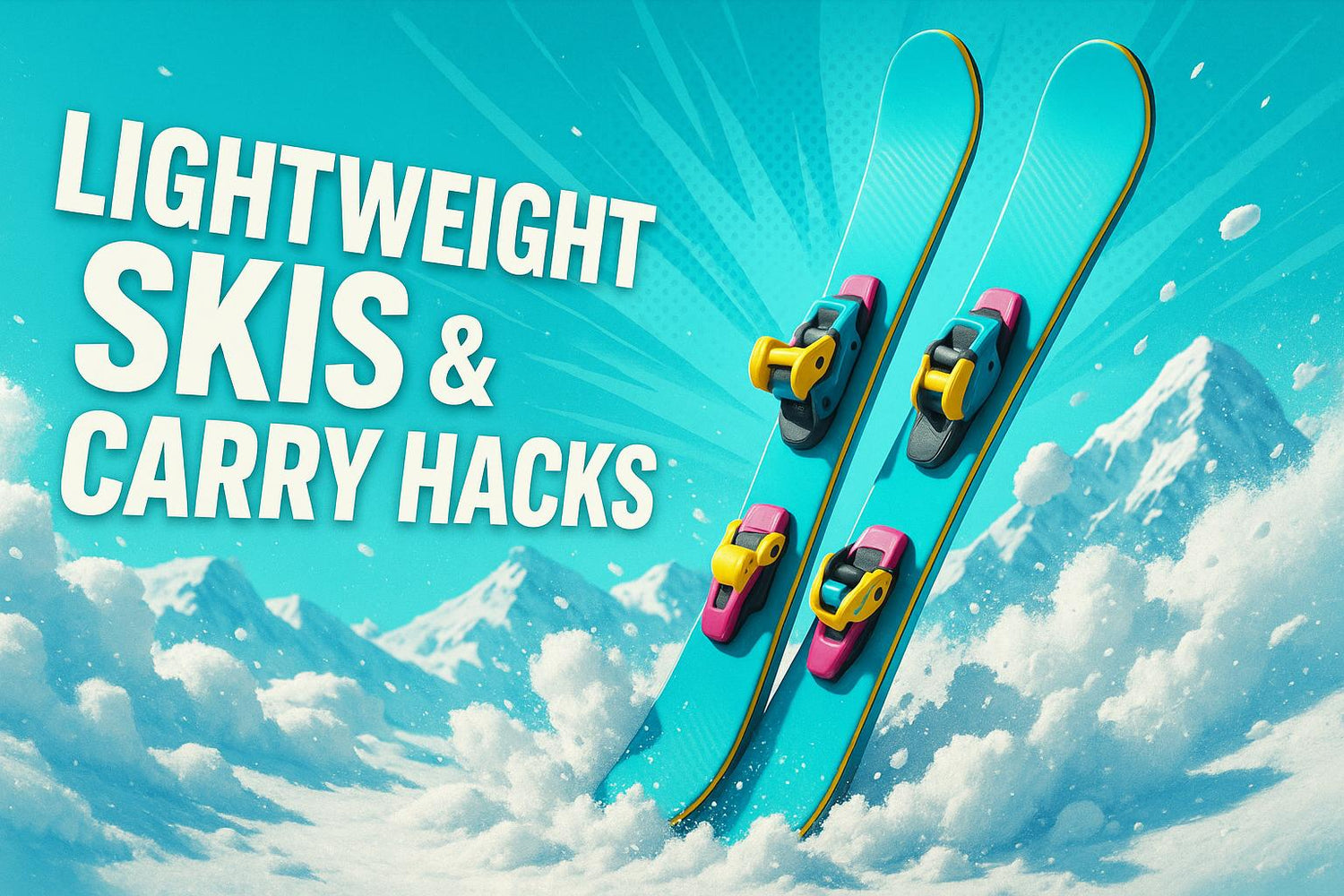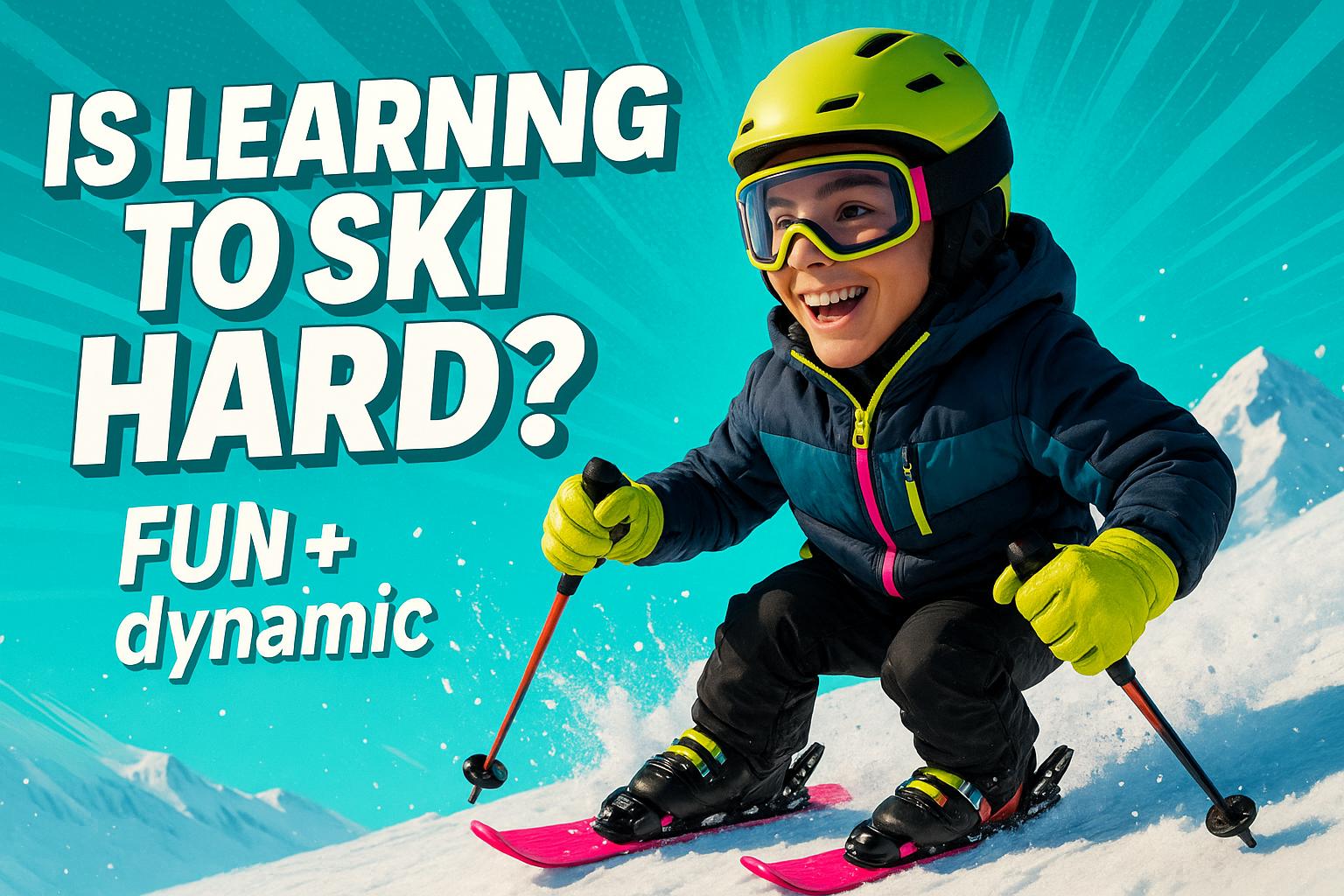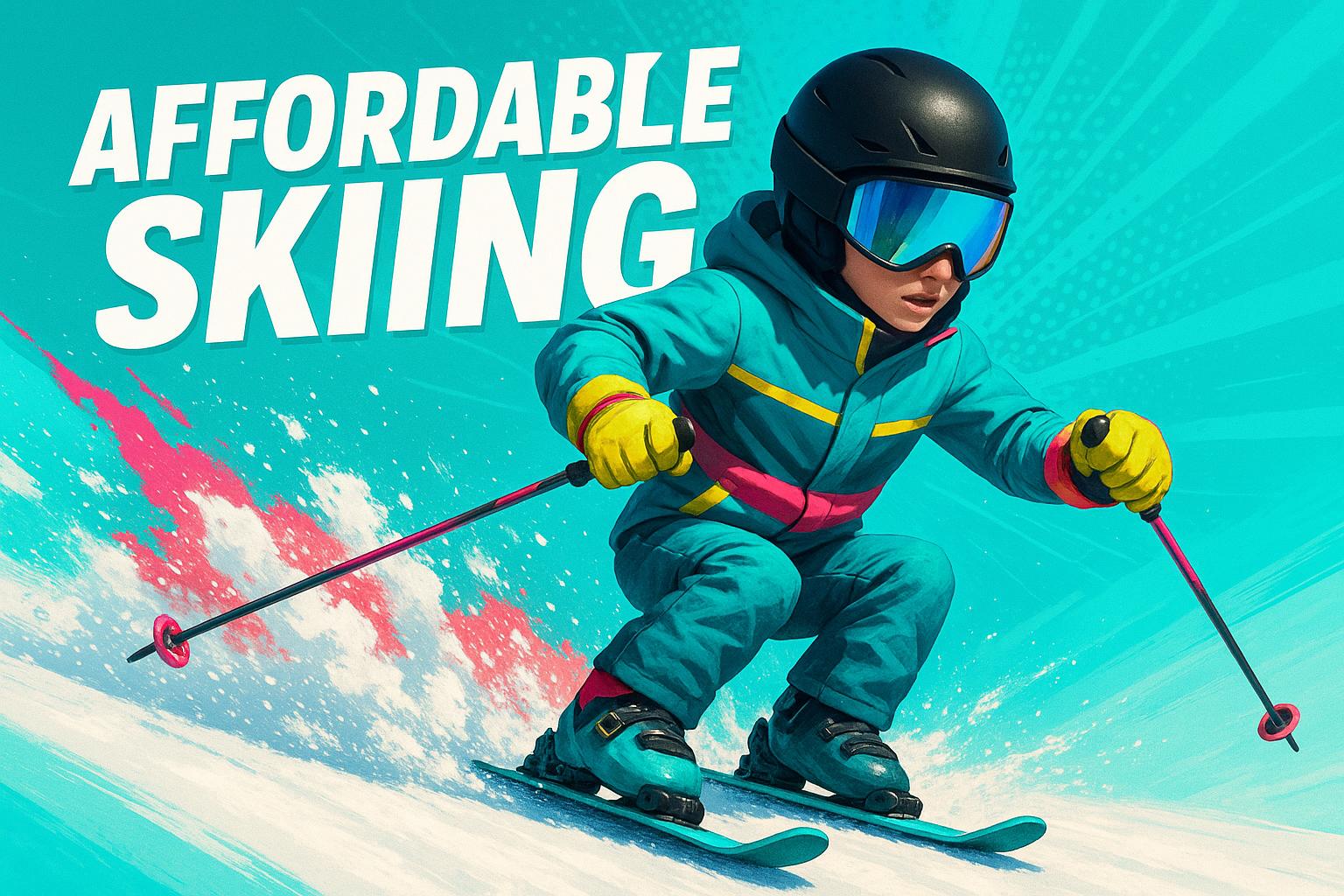重いギアの面倒なしでウィンタースポーツを楽しみたいですか? Snowfeetのコンパクトモデルのような軽量スキーがゲームチェンジャーです。持ち運びやすく、手頃で使いやすいので、初心者からベテランスキーヤーまで完璧です。ここが検討する価値がある理由です:
- コンパクトで持ち運びやすい:Snowfeet skisは17インチから47インチまであり、バックパックに収まるほど小さいです。かさばるバッグやルーフラックは不要です。
- 特別なブーツは不要:普通の冬用シューズやスノーボードブーツで使え、追加費用はかかりません。
- 手頃な価格:140ドルから始まり、従来のスキーセット(800~1,500ドル)よりはるかに安価です。
- 多用途:ゲレンデ、トレイル、スノーパーク、さらには裏庭でも楽しめます。
- 簡単に習得可能:短いスキーは操作が簡単で、初心者に優しいです。
簡単比較表:
| モデル | 長さ | おすすめ | 価格 |
|---|---|---|---|
| Skiskates | 17インチ | 遊び心のあるライディング、携帯性 | $330 |
| Snowfeet PRO | 20インチ | オールラウンドな使用、柔軟性 | $230 |
| Skiblades | 39インチ | カービング、スピードコントロール | $450 |
かさばるギアは捨てて、軽量スキーで手間いらずの冒険を楽しみましょう。ゲレンデでも雪道の探検でも、Snowfeetならシンプルで軽く、楽しい体験ができます。
なぜ軽量スキーが伝統的なギアに勝るのか
伝統的なスキーギアの問題点
正直に言いましょう。Rossignol、Atomic、Head、Elanのようなブランドの伝統的なスキーギアは、冬のスポーツというよりもトレーニングのように感じられることがあります。ほとんどのスキーは5〜6フィートの長さで、持ち運びに不便で輸送もさらに難しいです。経験豊富なスキーヤー、エミリオ・トランプズはこう完璧にまとめています:
"友人とカープールするとき、ほとんどが普通の重いスキーを使っているのですが、彼らのスキーを車に積もうとすると、その重さにいつも驚かされます。"
問題はスキーだけではありません。硬いブーツやポール、その他のアクセサリーを加えると、突然物流の頭痛の種になります。すべてを運ぶには専用のバッグやルーフラックが必要になることもあります。これは初心者や高齢者、移動に制限のある人にとって特に負担になるでしょう。サイモン・クランプはその苦労をユーモラスに指摘しています:
"硬いスキーブーツを履いてスキーとポールをそれぞれ持ち歩くのが難しいなら、スノーボードを試してみてください。快適なブーツで、持ち運ぶギアは4つではなく1つだけです。"
この面倒さが示すのは、もっとシンプルで使いやすい代替手段の余地があるということです。
Snowfeetの利点:サイズ、重量、携帯性

ここでSnowfeetが登場し、ゲームを変えます。6フィートを超えることもある従来のスキーとは異なり、Snowfeetの製品は驚くほどコンパクトです。Skiskatesはわずか17インチ(44cm)、そしてShort Skisでも最大約47インチ(120cm)です。この劇的なサイズダウンには大きな利点があります。スキーギアを普通のバックパックに放り込めることを想像してみてください。かさばるケースも、ルーフラックも、ストレスもありません。
もう一つの利点?Snowfeetのギアは普段の冬用ブーツで使えます。そうです、硬くて特殊なスキーブーツに投資する必要はありません。さらに、Snowfeetの多用途性は斜面だけにとどまりません。ハイキングトレイル、クロスカントリーパス、さらには雪に覆われた自宅の庭でも、そのギアは簡単に適応します。そして価格は?約140ドル。従来のセットアップ(スキー、ブーツ、ビンディング、ポール)に800ドルから1,500ドルかかることを考えれば、Snowfeetはより予算に優しい選択肢を提供していることが明らかです。
安定性とパフォーマンスの真実
長くて重いスキーの方が安定しているという一般的な考えがあります。しかし、現代の短いスキー技術はその考えを覆します。ミニスキー、特にSnowfeetのものは、斜面で楽しく機敏な体験を提供します。Snowfeetチームはこう説明しています:
"ミニスキーは初心者やクレイジーなフリースタイルライダーだけのものだと誤解されがちですが、実際には敏捷性、遊び心、そして斜面でのコントロールを重視する誰にとっても素晴らしい選択肢です。"
短いスキーは学習のハードルも下げます。初心者にとって操作が簡単で、ターンや停止がしやすくなります。Snowfeetチームが言うように:
"ミニスキーは初心者にとって優れた選択肢です。なぜなら長いスキーよりも操作が簡単だからです。短い長さのおかげでターンや停止がずっと簡単になり、新しいスキーヤーは基本技術の習得に集中でき、圧倒されることがありません。"
パフォーマンスに関して言えば、Snowfeet製品は確かな実力を持っています。例えば、99cmのSkibladesは完璧な5.0/5の評価を誇り、Skiskatesも4.9/5とほぼ同等の評価です。スキーボードのサポート構造やスノーブレードの幅広いプロファイルなどの特徴がバランスと安定性を高めており、コンパクトなギアでも大きな成果を出せることを証明しています。Snowfeetはレクリエーションスキーヤーのパフォーマンスの概念を塗り替え、軽量で短いギアでも楽しさやコントロールを犠牲にしないことを示しています。
2025年のベストスキーキャリア、スキーバックパック、スキーラゲッジ
Snowfeet製品ガイド:すべての冒険に対応するモデル
Snowfeetはほぼすべての冬の冒険に対応するコンパクトな製品ラインナップを作り上げました。各モデルが何を提供するのか、詳しく見てみましょう。
Skiskates 44 CM:小さなサイズ、大きな楽しさ
Skiskatesは世界最短のスキーの称号を持ち、長さはわずか17インチ(44 cm)です。これらのミニマーベルはスキーとスケートの良さを融合し、アイスホッケーやローラーブレード愛好者に人気です。330ドルで、小さなパッケージに大きな力を詰め込んでいます。
サイズは小さいですが、本物のスキーのような体験を提供します。さらに、スキーとスノーボードの両方のブーツに対応するよう設計されています。4.9/5の高評価で、ユーザーは携帯性とパフォーマンスを気に入っています。そして何より、バックパックに入るほど小さいので、かさばるギアを持ち運ぶ必要がありません。
Snowfeet PRO 50 CM:多用途性と利便性の融合
Snowfeet PROは柔軟性と使いやすさを追求しています。230ドルの価格で、これらの20インチモデルは通常の冬用ブーツに対応しており、専門のスキーブーツは不要です。調整可能なバインディングを備え、さまざまな色があり、フィット感やスタイルを好みに合わせて調整できます。4.9/5の評価で、トレイル、クロスカントリーパス、そり遊びの丘でも人気です。
PROの特徴はそのシンプルさです。高価なレンタルや硬いスキーブーツは忘れてください。普段の冬用ブーツに装着するだけで、どこでも雪上に出られます。簡単に楽しめるスノーファンです。
Skiblades 99 CM:真剣なスキーヤーのための精密さ
カービングターンを愛し、コントロールを求める人にとって、Skibladesは夢の実現です。99 cmの長さは安定性に十分でありながら、機敏さも保ちます。これらは中級スキーヤーがかさばらずにパフォーマンスを求める際の定番オプションです。
そしてレビューは?完璧な5.0/5評価。Snowfeetチームはこう表現しています:
"Skibladesは簡単にカービング、ジャンプ、探検ができます。軽量設計により、挑戦的なパウダー条件でもすべてのターンが自然で反応良く感じられます。"
450ドルから始まるSkibladesは、中〜急斜面やパウダーに最適です。既存のブーツにも対応しているので、追加のギアに無駄遣いする必要はありません。狭いスペースや複合地形をナビゲートする際も、これらのスキーは素早くシャープなターンと滑らかなコントロールを実現します。
| Skibladeの長さ | おすすめ | 地形 | 価格帯 |
|---|---|---|---|
| 44 cm Skiskates | 遊び心あふれるライディング、最大の携帯性 | なだらかな斜面、スノーパーク | 330ドルから |
| 50 cm Snowfeet PRO | オールラウンドな多用途性、ブーツの柔軟性 | ミックスドテレイン、トレイル、裏庭 | $230 |
| 99 cm Skiblades | カービング性能、スピードコントロール | 中〜急斜面、パウダー | 450ドルから |
各モデルには独自の特長がありますが、すべてに共通するSnowfeetの哲学は同じです:重いブーツなし、複雑なギアなし、収納の悩みなし。次は、その携帯性を最大限に活かす賢い持ち運びのヒントを見ていきましょう。
sbb-itb-17ade95
雪の旅を楽にする持ち運びのヒント
Snowfeetは、RossignolやAtomicのようなブランドの従来のスキーが必要とする大きなスキー用バッグやルーフラックなしで、普通のバックパックに収まるギアを設計し、冬の旅行をより簡単にしました。Snowfeetがギアの持ち運びを楽にする実用的な3つの方法をご紹介します。
バックパックに優しいデザイン
Snowfeet PROのサイズは約17 x 6 x 5インチ、重さはわずか3.3ポンドです。これはほとんどのノートパソコンよりも小さくて軽いことになります!HeadやElanのようなブランドの従来のスキーは5〜6フィートの長さでかさばるスキー用バッグが必要です。Skiskatesはわずか17インチで、標準的なハイキング用バックパックや大きなスクールバッグにも簡単に収まり、ルーフラックは不要です。Allyson Brownが言うように、「持ち運びもLyftの乗り降りもとても簡単です」。長さ99cmのSkibladesも標準的なスキー用バッグに収まり、他のギアのための余裕もあります。
多用途キャリーソリューション
Snowfeetの調節可能なビンディングは二役をこなします—足だけでなく、ヘルメットやゴーグル、服をバッグの外側に固定するストラップとしても使え、バッグの中のスペースを空けられます。Snowfeetはスキー用バッグに入れたり、服で包んで追加の保護をすることも可能です。さらに、ビンディングはバンジーコードの取り付けポイントにもなり、輸送中のギアの固定が簡単になります。この賢いデザインで航空旅行のパッキングがずっと楽になります。
軽装での旅行:空港でのヒント
コンパクトなサイズのおかげで、SkiskatesとSnowfeet PROは機内持ち込み手荷物にぴったり収まり、面倒な受託手荷物料金を回避できます。長めのSkibladesの場合は、圧縮キューブを使ったり、服を丸めてスキー用の受託手荷物のスペースを節約しましょう。スキー用バッグには連絡先をラベル付けするのを忘れずに。受託手荷物受取所で見つけやすくなります。
混雑した空港、小さなホテルの部屋、レンタカーの中でも、Snowfeetの携帯性が冬の旅行をストレスフリーにします。
軽量スキーへの切り替え方法:成功のためのヒント
伝統的な長いスキーからSnowfeetのコンパクトモデルへの移行は、スキー技術の完全な見直しを必要としませんが、いくつかの技術的な調整は必要です。Snowfeetスキーの短いデザインは非常に反応が良く操作しやすいため、ほとんどのスキーヤーはすぐに適応します。この移行をできるだけスムーズにする方法を分解してみましょう。
基本を学ぶ:長いスキーから短いスキーへ
Snowfeetのコンパクトなサイズは重心を下げ、より多くのコントロールを可能にすることでゲームチェンジャーとなります。始めるには、体重を中心に保ち、脚を肩幅程度に開いたまっすぐな姿勢を維持することに集中しましょう。ホッケー選手のようにスケートするイメージを持つと、この動きが短いスキーの感覚を掴むのに役立ちます。膝を曲げ、肩の力を抜いて、これらのスキーが提供する簡単なスノープラウ停止を活用しましょう。
短いスキーでの停止は少し異なるため、エッジを使った停止やホッケーストップを練習し、体重のバランスを保ちましょう。Snowfeetチームは次のように説明しています:
"結論として、スキーボードでの停止は伝統的なスキーでの停止に似た技術の組み合わせが必要ですが、いくつかの違いを覚えておく必要があります。"
- Snowfeetチーム
自信をつけるために緩やかな斜面から始めましょう。経験豊富なスキーヤーは最初は短いスキーに違和感を覚えるかもしれませんが、追加されたコントロール性が初期のぎこちなさを補うことが多いです。
適切な地形の選び方
基本をマスターしたら、スキルと自信を築くために適切な地形を選ぶことが重要です。Snowfeetモデルは非常に多用途ですが、初心者は整備されたバニースロープが最も始めやすい場所です。滑らかで整えられた雪は、これらのコンパクトスキーのコントロールを格段に簡単にします。地元のそり遊びの丘や雪の積もった裏庭でも練習できます。
カリフォルニア州ビッグベアの専門家は、初心者にはバニースロープに集中し、これらの軽量スキーで安全にスピードをコントロールするために停止技術を習得することを勧めています。
異なるSnowfeetモデルは、さまざまな状況で輝きを放ちます。Skiskates(44 cm)は整備されたゲレンデやスノーパークに最適で、Skibladesはカービングやよりダイナミックな滑走に理想的です。そのコンパクトなサイズは、伝統的な長いスキーでは難しいかもしれないハイキングトレイルや小さな丘にも最適です。例えば、2024年7月にMichael HirschはチリのLas Araucarias Ski CenterでSnowfeet Skiblades 65 cmを簡単にマスターしました。同様に、インディアナポリスのAllyはKeystone訪問中にSnowfeet Mini Ski Skatesの携帯性を気に入りました。
始めたばかりのときは、急な斜面や深いパウダーは避けましょう。短いスキーの独特な感触に慣れるために整備されたトレイルを使いましょう。エッジを使って速度をコントロールし、ターンを開始することに集中し、バランスを保つためにスタンスを少し調整します。別のSnowfeetチームの専門家はこうアドバイスしています:
"短いスキーでは、バランスとコントロールを維持するためにスタンスを少し調整する必要があるかもしれません。スキーの上に体重を中心に保ち、前後に傾きすぎないようにしましょう。"
- Snowfeetチーム
Snowfeetの最大の魅力の一つはその柔軟性です。スキーリゾート、地元の丘、さらには自宅の裏庭など、雪があればほぼどこでも練習できます。伝統的なスキーは慎重に整備された斜面が必要ですが、Snowfeetは可能性の世界を広げます。
結論:Snowfeetで雪の冒険に備えよう
かさばるセットアップや重いブーツにさよならを。Snowfeetは冬のスポーツのゲームチェンジャーであり、伝統的なギアに代わるシンプルで軽量な選択肢を提供します。RossignolやAtomicのような大手ブランドがスキーリゾート向けの長くて重い装備に注力する一方で、Snowfeetはどんな雪の丘もあなたの個人的な遊び場に変えます。
さまざまなモデルから選べるSnowfeetは、いつでもアクションの準備ができています。超コンパクトな44cmのSkiskatesから適応性の高い99cmのSkibladesまで、これらのオプションは携帯性とパフォーマンスを兼ね備えています—しかも伝統的なスキーのほんの一部のコストで。6フィートのスキーや重いブーツを空港やハイキングコースで運ぶ手間を想像してみてください。Snowfeetなら、軽装での旅行はもはや夢ではなく現実です。
Snowfeetは全く新しい自由のレベルをもたらします:普段のブーツに装着してすぐに雪の上へ。スキーブーツのレンタルや長いリフト待ち、指定されたスキーエリアに縛られるのはもう忘れましょう。Snowfeetチームが言うように:
"スキーなんていらない、Snowfeet*があれば?"
多用途性は自ずと証明されており、顧客評価は常に4.9から5.0スターの間で推移しています。どこでもユーザーは、時には短い方が賢いと気づいています。
それに加えて、習得の難易度は驚くほど簡単です。伝統的なスキーの習得には何年もかかることがありますが、ほとんどのSnowfeetユーザーは、追加されたコントロール性と操作性のおかげで、すぐに自信を持てるようになります。
重いギアを置いていく準備はできましたか?次の冬の冒険が呼んでいます—そしてそれはバックパックに収まるほど小さいです。Snowfeetは冬のスポーツをよりシンプルに、軽く、そしてずっと楽しくしました。
よくある質問
経験豊富なスキーヤーにとって、Snowfeetスキーは伝統的な長いスキーと比べてどのようなパフォーマンスを発揮しますか?
Snowfeetスキーはスキーに新しい風を吹き込み、熟練スキーヤーが喜ぶ機敏さと利便性のミックスを提供します。伝統的な70インチ以上の長いスキーは、特に広い斜面での高速時に安定性とエッジコントロールに優れています。しかし、17インチから47インチのSnowfeetのコンパクトなデザインは、素早いターン、モーグルのナビゲート、テレインパークの攻略で注目を浴びます。活発で反応の良いライドを求める人のために作られています。
さらに、軽量で持ち運びやすいデザインなので、持ち運びも楽で疲れにくいです。かさばるギアと格闘する必要はもうありません—スロープを楽しむ時間が増えます。さまざまな地形で新しく多用途なものを試したい経験豊富なスキーヤーなら、Snowfeetスキーは次のお気に入りになるかもしれません。
Snowfeet製品に最適な地形の種類は何で、制限はありますか?
Snowfeetギアは整備されたトレイル、テレインパーク、新雪で輝きます。軽量でコンパクトなサイズのおかげで、これらの環境でのコントロール性が高く、操作もとても簡単です。
とはいえ、すべてに最適というわけではありません。非常に硬く締まった雪面や氷の上では、Snowfeetはあまりパフォーマンスを発揮しないかもしれません。また、バックカントリーの冒険や伝統的なスキーやスノーボードが適しているような険しい地形には向いていません。しかし、ほとんどのカジュアルな雪遊びには、かさばる伝統的な装備の代わりに楽しく手軽な選択肢です。
伝統的なスキーからSnowfeetの軽量モデルに切り替える際のベストなコツは何ですか?
伝統的なスキーからSnowfeetの軽量オプション、SkibladesやSkiskatesに切り替えるのは、いくつかの便利なコツでかなり簡単です。まずはスキーの真ん中に体重を乗せることから始めましょう。Snowfeet製品は通常のスキーより短いため、このバランスの取れた姿勢が安定を保ち、エッジの切り替えをスムーズにします。初めての方は、膝を曲げて少し広めのスタンスを試してみてください。よりコントロールしやすく自信がつきます。
動き出す準備ができたら、横に押し出すスケーティング動作を使いましょう。この方法はSnowfeetのコンパクトなサイズにぴったりで、ターンや停止が簡単になります。足首と膝をしっかり使ってコントロールを高め、これらの軽量モデルが持つ機敏さを最大限に活かしましょう。これらの簡単な調整で、すぐにプロのように滑り回り、Snowfeetの自由と楽しさを満喫できます!


































コメントを残す
このサイトはhCaptchaによって保護されており、hCaptchaプライバシーポリシーおよび利用規約が適用されます。